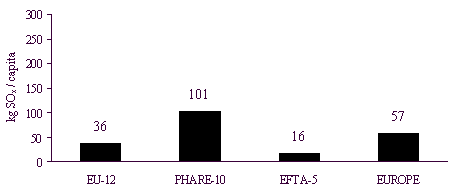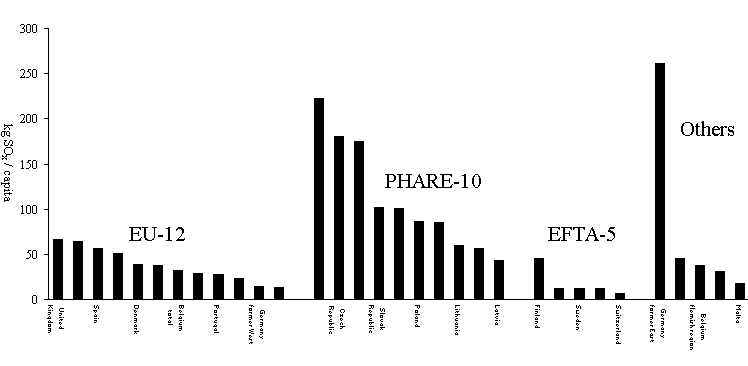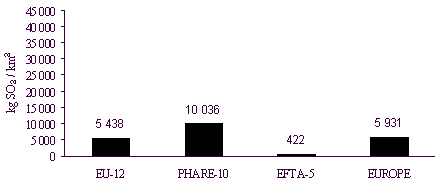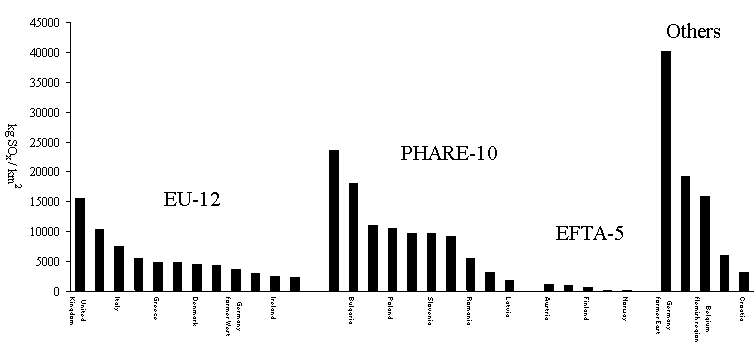1. SULFUR OXIDES - SOx
1.1 SOx-emissions by countries
The 1990 annual total SOx-emissions for
EUROPE were estimated to be 28 million tonnes as SOx. These emissions broken
down by EU-12, EFTA-5 and PHARE-10 countries are shown in figure 1.1. The largest
contributor were the EU-12 countries with 44%, second largest the PHARE-10 countries with
38%; Germany (former East), Croatia and Malta contributed 16% and the EFTA-5 countries 2%.
Figure 1.1: Contribution in % to the EUROPEAN total
SOx-emissions

Figure 1.2 shows the relative contribution of
individual countries to the total of 28 million tonnes. In 1990 the largest contributing
countries were Germany (former East; 15%), the United Kingdom (14%), Poland (12%) and
Italy (8%); the smallest contributing countries were Malta (0.02%), Luxembourg (0.05%),
Switzerland (0.16%) and Austria (0.3%). These differences are due to different size of
population, different per capita emissions (see
also paragraph 1.3) and differences in emissions from natural sources. Different per
capita emissions are due to different types of human activities and differences in air
pollution control measures.
Figure 1.2: Contribution in % of each country to the
EUROPEAN total SOx-emissions

1.2 SOx-emissions per group
Ninety percent of the SOx-emissions for
EUROPE in 1990 resulted from emissions of group 1 (public power, cogeneration and district
heating), group 2 (commercial, institutional and residential combustion) and group 3
(industrial combustion). Group 1 contributed the largest share with 54%, group 3 and group
2 were the groups with the next largest contribution almost exclusively of 25% and 11%.
The remaining 10% of the total emissions can be attributed almost exclusively to emissions
of the groups 4 (production processes), 7 (road transport), 8 (other mobile sources and
machinery) and 11 (nature).
The split of the SOx-emissions into
groups for EU-12 and PHARE-10 countries is quite similar compared to the split for EUROPE
with the exception of the relative large contribution from group 11 (nature) for EU-12
countries which is due to the emissions of volcanoes, mainly in Italy. The split into
groups for EFTA-5 countries is different from that already described split for EUROPE (see
figure 1.3). The largest contribution from the EFTA-5 countries is group 3 (industrial
combustion) with 34%, the second largest group is group 1 (public power, cogeneration and
district heating) with 21% followed by group 4 (production processes) with 20%.
The differences of contributions of the main source
groups 1, 2 and 3 to the total emissions are larger between countries than these groups
(see also table 1.1). The contribution of group 1 in the
countries ranges from 79% (Slovenia and Estonia) to 1% (Luxembourg), contribution of group
2 SOx-emissions ranges from 33% (Switzerland) to 2% (Netherlands, Portugal,
Estonia) and contribution of group 3 SOx-emissions ranges from 87% (Luxembourg)
to 3% (Latvia).
However it is evident from these differences in the
relative contribution of source groups to a countries total emissions that strategies for
reduction of SOx-emission need individual solutions as well as common elements.
Figure 1.3: Contribution in % of source groups to
the EUROPEAN SOx-emissions

1.3
SOx-emissions per capita
Only anthropogenic emissions are expected to be
related to population for these calculations. Therefore group 11 (nature) has been
excluded.
For EUROPE the average SOx-emissions per
capita were 57 kg/capita. Compared to this number the per capita SOx-emissions
were 77% larger for the PHARE-10 countries with 101 kg/capita, 37% smaller for the EU-12
countries with 36 kg/capita and 72% smaller for the EFTA-5 countries with 16 kg/capita.
This comparison is also shown in figure 1.4 and table 9.
Again the differences are much larger if individual
countries are compared; the largest SOx-emissions per capita were estimated for
Germany (former East; 261 kg/capita) and the next largest ones for Bulgaria (223
kg/capita) and Czech Republic (181 kg/capita); the smallest per capita emissions for SOx
were calculated for Switzerland (7 kg/capita), Sweden and Austria (each 12 kg/capita),
Norway (13 kg/capita), the Netherlands (14 kg/capita) and Germany (former West; 15
kg/capita). Figure 1.5 shows the countries ranked according their per capita emissions.
The already mentioned special report for SOx will analyse these large
differences of the per capita emissions for SOx, the smallest per capita
emissions being a factor of 37 smaller compared to the largest number.
Figure 1.4: SOx-emissions per capita for
EUROPE

Figure 1.5: SOx-emissions per capita for
individual countries

1.4 SOx-emissions per km2
The emissions per km2 have been
calculated from the total emissions, the emissions of group 11 (nature) having been
included in this case.
For EUROPE the average SOx-emissions per
km2 were estimated as 5 931 kg/km2. Compared to this number the per
km2 SOx-emissions were 69% larger for the PHARE-10 countries with 10
036 kg/km2, 8% smaller for the EU-12 countries with
5 438 kg/km2 and 93% smaller for the EFTA-5 countries with 422 kg/km2.
This comparison is also shown in figure 1.6 and table 10.
Figure 1.6: SOx-emissions per km2
for EUROPE

Again the differences are much larger if individual
countries are compared; the largest SOx-emissions per km2 were for
Germany (former East; 40 088 kg/km2) and the next largest ones for Czech
Republic (23 618 kg/km2), Malta (19 199 kg/km2) Bulgaria (18 106
kg/km2) and Belgium, Flemish region (15 829 kg/km2); the smallest
emissions per km2 for SOx were for Norway (165 kg/km2),
Sweden (233 kg/km2), Finland (671 kg/km2) and Switzerland (1 068
kg/km2). Figure 1.7 shows the countries ranked according their SOx-emission
per km2. The differences in the emissions per km2 between countries
are much larger compared to the differences of the per capita emissions. The smallest
number being 243 times smaller than the largest number.
Figure 1.7: SOx-emissions per km2
for individual countries

Table 1.1: Sulfur oxides
emissions per country and group








Document Actions
Share with others